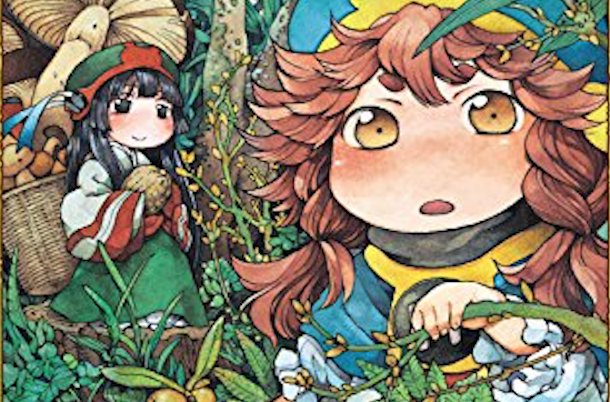
Living the Tiny Life: ‘Hakumei & Mikochi’ Vol. 1
Hakumei & Mikochi: Tiny Little Life in the Woods Vol. 1
Writer/artist: Takuto Kashiki
Yen Press; $15
Rated T for Teen
There’s a fundamental tension between the fantastic and the mundane that serves as a sort of engagement engine for Takuto Kashiki’s Hakumei & Mikochi. The title characters themselves belong to some unspecified species of tiny, doll-like humanoids, standing no taller than some insects and bearing big, round heads atop child-like bodies. They and other elfin fairy people live side-by-side with talking animals, and some of the stories feature truly remarkable imagery in service of such imaginative content as a tiny scientist who has found a way to reanimate animal skeletons through artificial, music-powered hearts or clouds formed from the spirits of household items descending upon a festival.
 And yet the society formed by these little people and the animals is so familiar it could pretty much be any rural area in the post-industrial world, and Hakumei and Mikochi’s adventures tend to revolve around standard rituals of almost anybody’s domestic life: Preparing and sharing meals, spending a day on a shopping excursion, going camping, going to work, crafting, and so on. One of the most dramatic stories in this first volume of the new series involves the two friends embroiled in what amounts to a particularly competitive board game against a pair of sisters. Even in the most fantastical stories, like those mentioned above, the real focus is not on the technological necromancy or the sentient spirits of inanimate objects but on the differences in the two friends’ characters.
And yet the society formed by these little people and the animals is so familiar it could pretty much be any rural area in the post-industrial world, and Hakumei and Mikochi’s adventures tend to revolve around standard rituals of almost anybody’s domestic life: Preparing and sharing meals, spending a day on a shopping excursion, going camping, going to work, crafting, and so on. One of the most dramatic stories in this first volume of the new series involves the two friends embroiled in what amounts to a particularly competitive board game against a pair of sisters. Even in the most fantastical stories, like those mentioned above, the real focus is not on the technological necromancy or the sentient spirits of inanimate objects but on the differences in the two friends’ characters.
ADVERTISEMENT
ADVERTISEMENT
And so Kashiki’s manga doesn’t so much see-saw between a hidden fanciful fairy world and familiar daily life as it super-imposes one upon the other, every panel on every page of every story existing in both states simultaneously. The delivery of the newspaper is fascinating, because the paperboy is a perfectly realistically rendered grasshopper. Hakumei’s job repairing a worn-out piece in a run-down windmill is unusual because her boss is a talking weasel who apparently rolls his own weasel-sized cigarettes. There’s an intimate familiarity, an almost tactile level of coziness to the goings-on, the true subject matter always the relationship between the protagonists; it’s the ampersand in the title that gets the emphasis.
Mikochi is practical and a bit timid. An excellent cook and master of all domestic arts, she’s a natural born homemaker who tends toward homebodyhood. Hakumei, on the other hand, is energetic and reckless, an outgoing and adventurous type who pushes her friend as much as she depends on her. They’re not quite an odd couple, but they’re different enough to keep a degree of drama in their interactions and still complement one another in such a way that many of the stories can reinforce how important they are to one another…and, by extension, serve as a celebration of friendship in general.
The pair share a house in a hollow tree in the woods, and both seem to be productive, popular participants in their community. Each chapter is a complete short story all on its own, and the drama is always low-stakes, befitting the day-in-the-life spirit of the series. They go looking for a rare bird on a nearby mountain because they heard it grants a wish to those who find it in one story, then go looking for a ghost fish and end up making friends with a scientist in the next. Mikochi is named one of the best singers in the area, to the chagrin of a proud rival, and works to befriend her. They spend a day at an elaborate market, where they lose their wallet and find themselves bombarded by gifts. Hakumei goes to work. Mikochi makes jams and teas and learns how to make soap.
Kashiki has tapped into a fairly familiar vein in worldwide pop culture here, one that includes Hans Christian Andersen’s Thumbelina and Wil Huygen’s and Rien Poortvliet’s gnome books and Mary Norton’s The Borrowers and American cartoon mice like Jerry of Tom and Jerry fame and so on. But her finely detailed artwork, with all but the two lead characters and their kin drawn precisely representatively, makes it all seem new with its richness, and deceptively simple in its almost blasé presentation of the real world made magical and miniature as a plain fact of life.
About J. Caleb Mozzocco
J. Caleb Mozzocco is a way-too-busy freelance writer who has written about comics for online and print venues for a rather long time now. He currently contributes to Comic Book Resources' Robot 6 blog and ComicsAlliance, and maintains his own daily-ish blog at EveryDayIsLikeWednesday.blogspot.com. He lives in northeast Ohio, where he works as a circulation clerk at a public library by day.
ADVERTISEMENT
ADVERTISEMENT
SLJ Blog Network
One Star Review, Guess Who? (#202)
This Q&A is Going Exactly As Planned: A Talk with Tao Nyeu About Her Latest Book
Parsing Religion in Public Schools
Take Five: LGBTQIA+ Middle Grade Novels
ADVERTISEMENT








